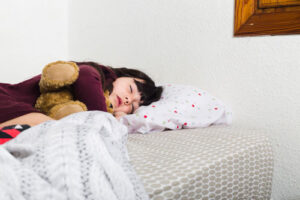Sleep is vital for a child’s physical and mental development. However, many children struggle with various sleep disorders that can significantly impact their overall well-being. Understanding the different types of sleep disorders and their potential impacts is crucial in providing effective support and solutions for these issues.

Identifying Common Sleep Disorders in Children
Certainly, understanding the common sleep disorders in children is crucial for early identification and effective management. Here are some elaborations on the various types of sleep disorders that children commonly experience:
Insomnia in Children
Insomnia refers to difficulty falling asleep or staying asleep, leading to inadequate rest. Children with insomnia may exhibit symptoms such as persistent bedtime resistance, frequent nighttime awakenings, or early morning awakenings. Identifying the root cause, such as anxiety, irregular sleep schedules, or certain medical conditions, is essential for implementing appropriate interventions.
Sleep Apnea in Children
Sleep apnea involves pauses in breathing or shallow breaths during sleep. In children, this can often be caused by enlarged tonsils or adenoids, which obstruct the airway. Symptoms may include loud snoring, restless sleep, and daytime sleepiness. Timely diagnosis and treatment of sleep apnea are crucial to prevent potential developmental and cognitive issues resulting from oxygen deprivation during sleep.
Parasomnias in Children
Parasomnias are a group of sleep disorders characterized by abnormal behaviors during sleep. These can include night terrors, sleepwalking, and confusional arousal. Children experiencing parasomnias may exhibit sudden awakenings, confusion, and even physical activities during sleep. Identifying triggers and implementing safety measures are essential in managing these episodes and ensuring the child’s well-being.
Circadian Rhythm Disorders in Children
Disruptions in the internal body clock can lead to circadian rhythm disorders, causing irregular sleep-wake cycles. This may manifest as difficulty falling asleep at a reasonable bedtime or waking up too early in the morning. Properly regulating the child’s exposure to light and maintaining a consistent sleep schedule can aid in managing circadian rhythm disorders.
Understanding the distinct symptoms and patterns associated with these common sleep disorders in children is crucial for prompt intervention and appropriate treatment. Early detection can significantly improve the child’s overall well-being and quality of life. If you suspect that your child is experiencing any of these sleep disorders, consulting a pediatrician or sleep specialist is recommended for accurate diagnosis and guidance on the most effective management strategies.

Impact of Sleep Disorders on Child Development
Understanding the profound impact of sleep disorders on child development is essential for parents, caregivers, and healthcare professionals. Sleep plays a critical role in the physical, cognitive, and emotional development of children. Here are some key insights into the potential consequences of sleep disorders on various aspects of a child’s development:
Cognitive Development
Adequate and quality sleep is vital for optimal cognitive functioning in children. Sleep disorders can disrupt the consolidation of memory, attention span, and overall cognitive abilities. Persistent sleep deprivation may lead to difficulties in learning, problem-solving, and academic performance. Children with untreated sleep disorders may exhibit challenges in concentration, memory recall, and cognitive processing, affecting their overall educational progress.
Emotional Well-being
Sleep disorders can significantly impact a child’s emotional well-being, leading to mood disturbances, irritability, and heightened emotional reactivity. Prolonged sleep disturbances may contribute to an increased risk of developing mood disorders, such as depression and anxiety, during childhood and later stages of life. Ensuring adequate and restful sleep is crucial for promoting emotional resilience and a healthy emotional state in children.
Physical Health
Sleep disorders can have detrimental effects on a child’s physical health and growth. Chronic sleep deprivation may weaken the immune system, making children more susceptible to illnesses and infections. Additionally, disruptions in sleep patterns can interfere with the release of growth hormones, potentially affecting a child’s physical development and growth trajectory. Addressing sleep disorders is crucial for promoting optimal physical health and supporting a child’s overall growth and development.
Behavioral Challenges
Sleep disorders can manifest in various behavioral challenges in children, including hyperactivity, impulsivity, and difficulty regulating emotions. Sleep-deprived children may display increased aggression, impatience, and difficulty in self-regulation. Addressing underlying sleep issues can help mitigate behavioral challenges and promote a more balanced and harmonious behavioral pattern in children.
Recognizing the comprehensive impact of sleep disorders on a child’s development underscores the importance of prioritizing healthy sleep habits and seeking timely interventions for any sleep-related concerns. Collaborating with healthcare professionals to identify and address sleep disorders can significantly contribute to promoting a child’s overall well-being and supporting their holistic development.

Strategies for Managing Sleep Disorders in Children
Implementing effective strategies to manage sleep disorders in children is crucial for ensuring they receive the necessary support for restful and rejuvenating sleep. Here are some valuable strategies that can aid in managing and improving sleep patterns in children:
Consistent Bedtime Routine
Establishing a consistent bedtime routine helps signal to the child’s body that it is time to wind down and prepare for sleep. This routine might include activities such as a warm bath, bedtime story, or soothing music. Maintaining consistency in these bedtime rituals can help regulate the child’s internal clock and promote better sleep quality.
Creating a Sleep-Conducive Environment
Designing a sleep-conducive environment involves creating a comfortable and soothing atmosphere in the child’s bedroom. This can include ensuring a cool, dark, and quiet room, using comfortable bedding, and minimizing any disruptive noises or lights that might disturb the child’s sleep. A calming sleep environment can significantly improve the child’s ability to fall and stay asleep throughout the night.
Promoting Healthy Sleep Hygiene Habits
Encouraging healthy sleep hygiene habits involves fostering behaviors that promote better sleep quality. This includes limiting screen time before bedtime, avoiding stimulating activities close to bedtime, and encouraging regular physical activity during the day to promote natural fatigue at night. Educating children about the importance of sleep hygiene empowers them to prioritize healthy sleep habits from a young age.
Seeking Professional Guidance
Consulting a healthcare professional, such as a pediatrician or a sleep specialist, is essential when managing persistent or severe ‘sleep disorders in children’. Healthcare professionals can offer personalized guidance, recommend appropriate interventions, and conduct necessary assessments to identify any underlying medical or psychological issues contributing to the sleep disorder. Following the expert’s advice and treatment plan can significantly improve the child’s sleep quality and overall well-being.Stress Reduction Techniques
For children experiencing sleep disorders due to anxiety or stress, teaching them stress reduction techniques, such as relaxation exercises, mindfulness, or deep breathing exercises, can be beneficial. These techniques can help alleviate anxiety, calm the mind, and promote a sense of relaxation, making it easier for the child to transition into a peaceful sleep.
Implementing these strategies consistently and in conjunction with each other can significantly contribute to managing and improving “sleep disorders in children”. Encouraging a holistic approach to sleep management fosters a positive sleep experience and supports the child’s overall health and development.

Promoting Healthy Sleep Habits for Children
Promoting healthy sleep habits for children is essential for ensuring that they develop a positive relationship with sleep from an early age. Cultivating these habits can contribute to improved sleep quality, overall well-being, and optimal development. Here are some effective ways to promote healthy sleep habits for children:
Consistent Sleep Schedule
Encouraging a consistent sleep schedule helps regulate the child’s internal body clock, promoting a predictable sleep-wake cycle. Establishing a regular bedtime and wake-up time, even on weekends, can support the child’s natural sleep rhythms and aid in better sleep quality.
Limiting Screen Time Before Bed
Restricting screen time, including television, computers, and mobile devices, before bedtime is crucial. The blue light emitted from screens can disrupt the production of the sleep hormone melatonin, making it challenging for children to fall asleep. Encouraging screen-free activities, such as reading a book or engaging in calming play, can help prepare the child for a restful night’s sleep.
Encouraging Physical Activity
Promoting regular physical activity during the day can contribute to better sleep quality at night. Engaging in outdoor play, sports activities, or simple exercises helps expend excess energy, promotes physical well-being, and enhances the child’s ability to achieve restful sleep.
Creating a Relaxing Bedtime Routine
Establishing a calming bedtime routine can signal to the child’s body that it is time to unwind and prepare for sleep. Incorporating soothing activities such as gentle stretching, meditation, or listening to soft music can help the child transition into a more relaxed state and facilitate a smoother bedtime experience.
Emphasizing a Comfortable Sleep Environment
Ensuring a comfortable sleep environment is crucial for promoting healthy sleep habits. Providing a supportive mattress, cozy bedding, and a suitable room temperature can contribute to a conducive and restful sleep environment for the child. Additionally, using nightlights or comfort objects can offer a sense of security and comfort, promoting better sleep quality.
Educating about the Importance of Sleep
Teaching children about the significance of sleep for their overall health and well-being is essential. Explaining the benefits of quality sleep, such as improved concentration, enhanced mood, and better physical health, can help foster a positive attitude toward sleep and encourage them to prioritize their sleep habits.
Encouraging these healthy sleep habits from an early age sets the foundation for a lifetime of good sleep hygiene, supporting the child’s growth, development, and overall quality of life.
Conclusion
In conclusion, recognizing and addressing sleep disorders in children is paramount for their overall health and well-being. By understanding the signs, impacts, and management strategies, parents and caregivers can ensure that their children receive the necessary support to establish healthy sleep patterns. If you have any experiences or insights regarding children’s sleep disorders, feel free to share your thoughts in the comments below.






